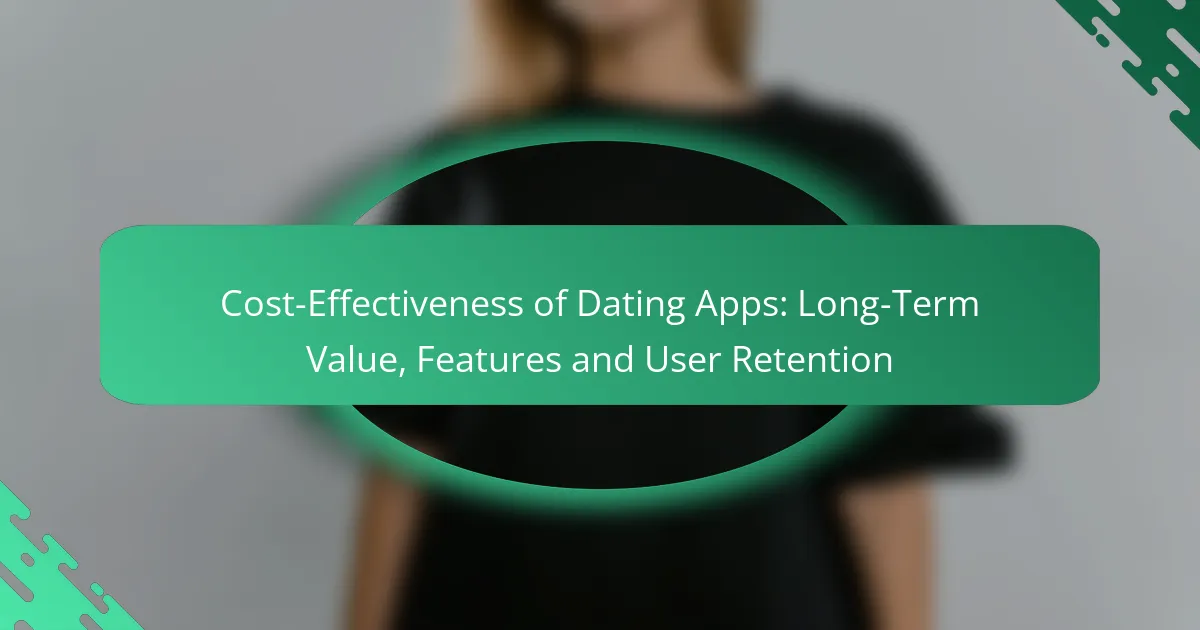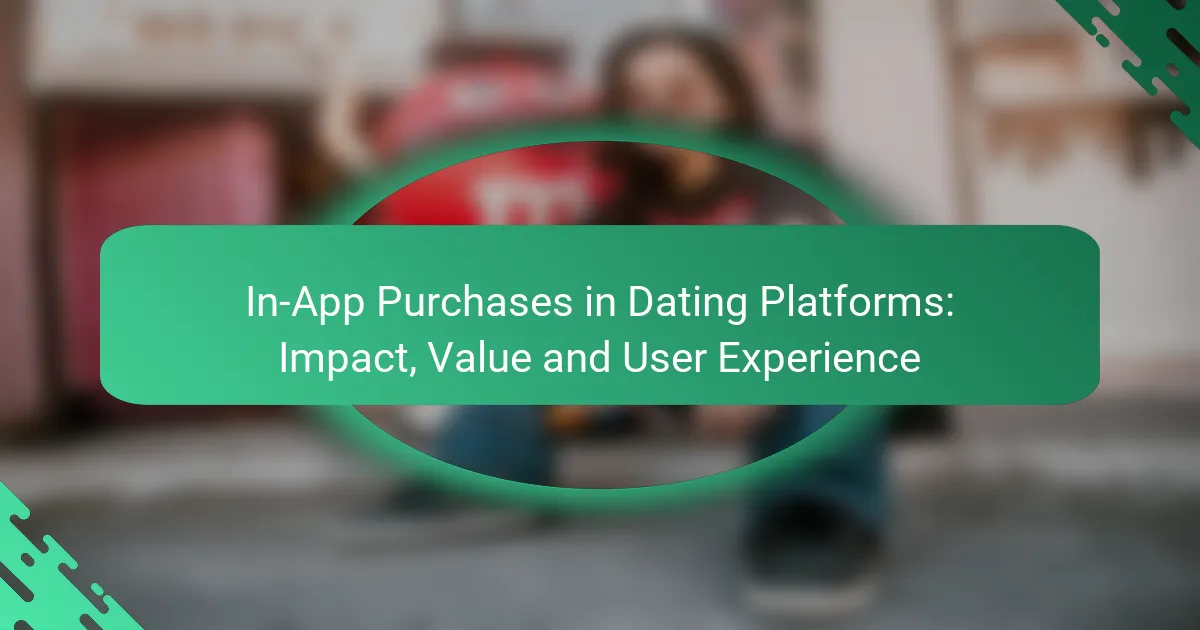Dating apps have revolutionized the way people connect, offering long-term value through features that enhance user engagement and access to diverse dating pools. With advanced algorithms and subscription models, these platforms not only provide cost savings but also foster meaningful connections over time. User retention is driven by user-friendly interfaces, personalized recommendations, and effective communication tools, making the choice of app crucial for a sustainable dating experience.
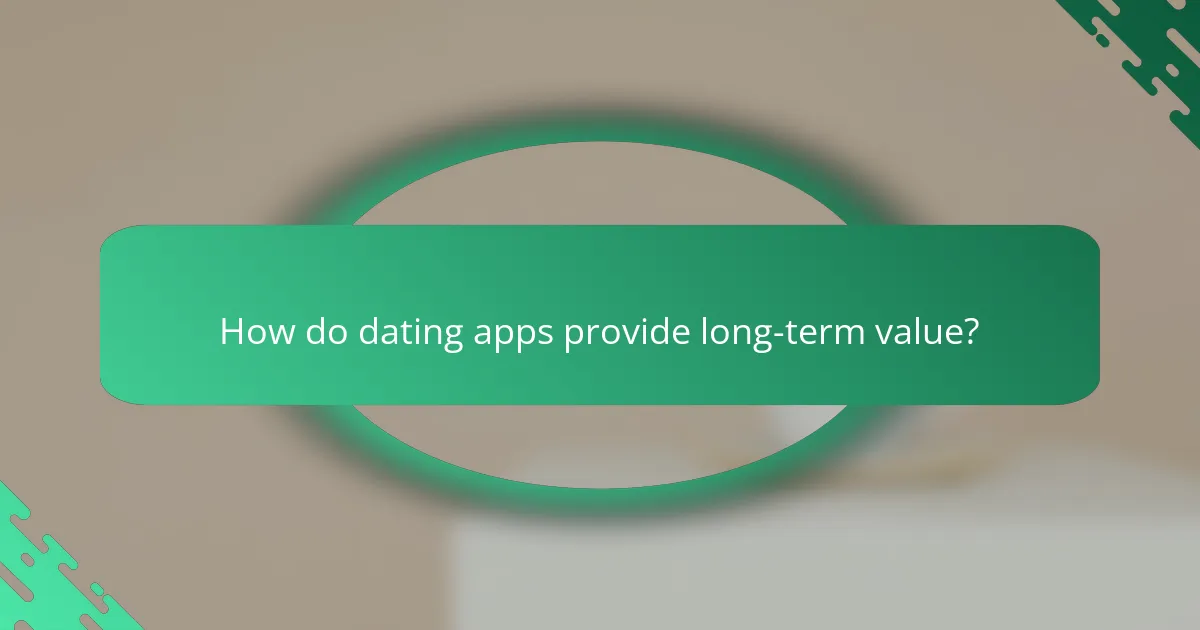
How do dating apps provide long-term value?
Dating apps offer long-term value through features that enhance user engagement, cost savings, and access to diverse dating pools. By leveraging advanced algorithms and subscription models, these platforms create a sustainable dating experience that can lead to meaningful connections over time.
Increased user engagement
Dating apps boost user engagement by providing interactive features such as messaging, video calls, and profile customization. These elements encourage users to spend more time on the app, increasing their chances of finding a match. Regular updates and notifications also keep users returning, fostering a habit of engagement.
Moreover, gamification elements, like rewards for daily logins or successful matches, can further enhance user retention. This consistent interaction is crucial for building relationships and maintaining interest in the platform.
Cost savings compared to traditional dating
Using dating apps can be significantly more cost-effective than traditional dating methods, such as going out to bars or restaurants. Many apps offer free basic features, while premium subscriptions often cost less than a single night out. This affordability allows users to explore multiple connections without financial strain.
For instance, a monthly subscription to a popular dating app might range from $10 to $30, compared to spending $50 or more on a single date. This shift in spending habits makes dating more accessible, especially for younger users or those on a budget.
Access to diverse dating pools
Dating apps provide access to a broader range of potential partners than traditional dating methods. Users can connect with individuals outside their immediate social circles, increasing the likelihood of finding compatible matches. This diversity is particularly beneficial for those seeking specific relationship types or preferences.
For example, niche dating apps cater to particular interests, lifestyles, or demographics, allowing users to find like-minded individuals more easily. This targeted approach enhances the overall dating experience and can lead to more meaningful connections.
Enhanced matching algorithms
Advanced matching algorithms in dating apps analyze user preferences, behaviors, and interests to suggest compatible partners. These algorithms continuously learn from user interactions, improving the quality of matches over time. This data-driven approach increases the chances of successful connections.
Some apps even incorporate psychological principles or compatibility tests to refine their matching processes. As a result, users often find more suitable matches, leading to higher satisfaction and retention rates.
Long-term subscription benefits
Many dating apps offer long-term subscription plans that provide additional features and benefits. Users who commit to longer subscriptions often enjoy lower monthly rates and exclusive features, such as advanced search filters or unlimited messaging. This can enhance the overall dating experience.
Additionally, long-term subscribers may receive priority customer support and access to new features before they are rolled out to free users. These perks can significantly improve user satisfaction and encourage continued use of the app over time.
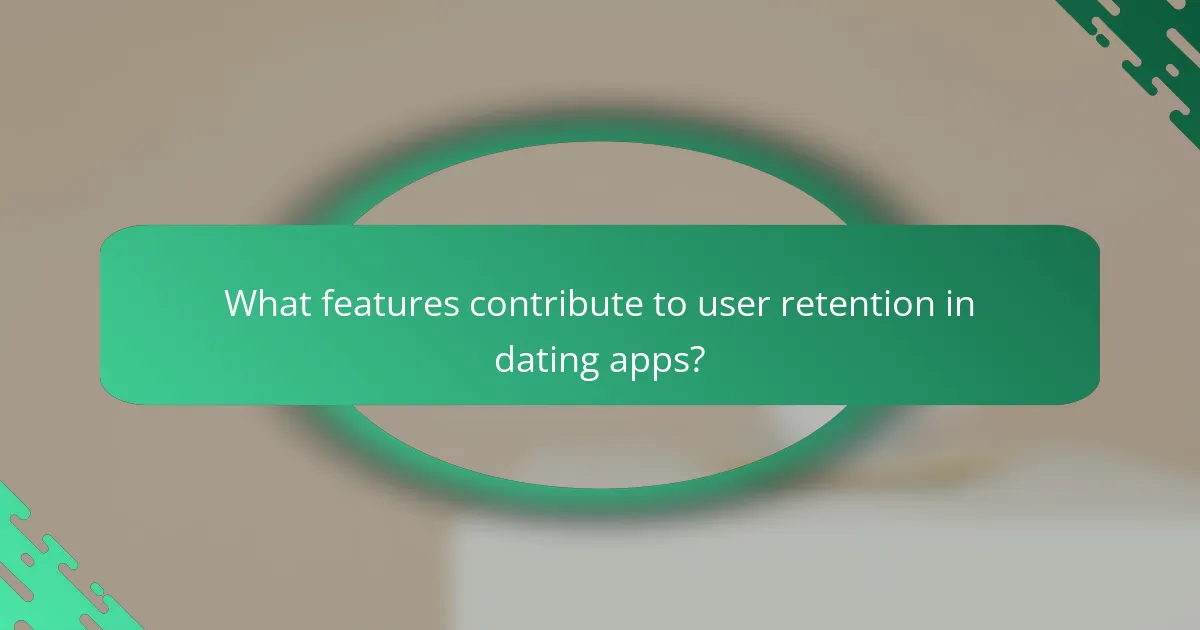
What features contribute to user retention in dating apps?
User retention in dating apps is significantly influenced by features that enhance the overall user experience. Key elements such as user-friendly interfaces, personalized recommendations, effective in-app communication tools, and robust safety and privacy features play a crucial role in keeping users engaged over time.
User-friendly interfaces
A user-friendly interface is essential for attracting and retaining users in dating apps. Intuitive navigation, appealing design, and easy access to features help users feel comfortable and engaged. Apps that prioritize simplicity often see higher retention rates, as users are less likely to abandon platforms that are difficult to use.
For example, apps that use clear icons and straightforward layouts allow users to quickly find matches and communicate, reducing frustration and enhancing satisfaction. Regular updates that refine usability can also help maintain interest and encourage continued use.
Personalized recommendations
Personalized recommendations are vital for enhancing user engagement in dating apps. By analyzing user preferences and behaviors, apps can suggest potential matches that align with individual interests, increasing the likelihood of meaningful connections. This tailored approach not only improves user satisfaction but also fosters a sense of investment in the app.
For instance, apps that utilize algorithms to learn from user interactions can provide increasingly accurate match suggestions over time. Users are more likely to stay active when they feel that the app understands their dating preferences.
In-app communication tools
Effective in-app communication tools are crucial for facilitating interactions between users. Features such as messaging, video calls, and voice notes allow users to connect in various ways, enhancing their overall experience. The ability to communicate easily can lead to deeper connections and increased user retention.
Apps that offer diverse communication options often see higher engagement levels. For example, platforms that allow users to send photos or engage in video chats can create a more dynamic and interactive environment, encouraging users to remain active participants.
Safety and privacy features
Safety and privacy features are paramount for user retention in dating apps. Users need to feel secure while interacting with others, and apps that prioritize safety through verification processes, reporting tools, and privacy settings tend to retain more users. A strong emphasis on user safety builds trust and encourages ongoing participation.
For example, apps that implement identity verification measures or allow users to control their visibility can significantly enhance user confidence. Providing clear guidelines on safety practices also helps users feel more secure, leading to a more positive experience overall.
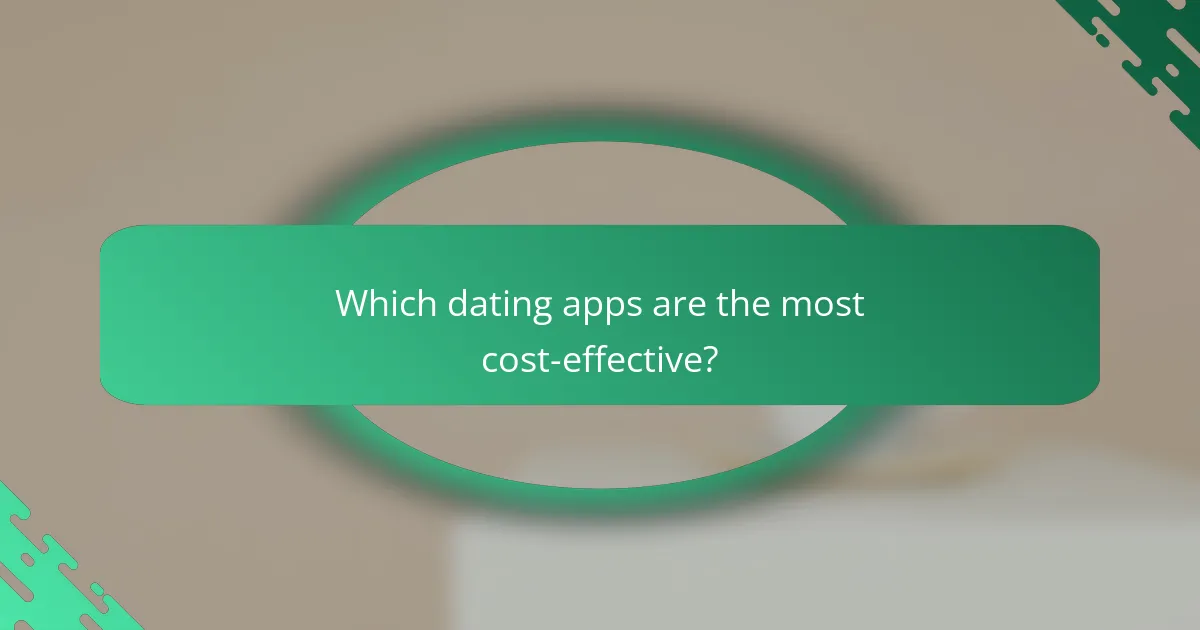
Which dating apps are the most cost-effective?
The most cost-effective dating apps typically offer a balance between subscription costs and the features provided. Users should consider both the upfront costs and the long-term value of the services when choosing an app.
Tinder (subscription options)
Tinder offers several subscription options, including Tinder Plus, Tinder Gold, and Tinder Platinum. Prices can range from approximately $10 to $30 per month, depending on the plan and the duration of the subscription. Each tier provides additional features, such as unlimited swipes, the ability to see who liked you, and access to premium features like Super Likes.
When evaluating cost-effectiveness, consider how often you use the app and whether the premium features enhance your experience. For casual users, the free version may suffice, while active users might benefit from a subscription.
Bumble (premium features)
Bumble offers a premium service called Bumble Boost, which provides features like extending matches and rematching with expired connections. The subscription typically costs between $10 and $25 per month, with discounts for longer commitments. Users appreciate the emphasis on female empowerment and safety, which can add value beyond just the features.
For those who prioritize safety and control in their dating experience, investing in Bumble Boost may be worthwhile. However, casual users can still find success with the free version, which allows for basic matching and messaging.
OkCupid (free vs. paid features)
OkCupid operates on a freemium model, where users can access many features for free, but paid subscriptions unlock additional functionalities. The cost for a subscription ranges from about $5 to $15 per month, depending on the length of the commitment. Paid features include seeing who liked you and additional question filters to refine matches.
For users who want to maximize their chances of finding a compatible match, investing in a subscription can be beneficial. However, the free version is robust enough for many users to find meaningful connections.
Hinge (value for money)
Hinge focuses on fostering serious relationships and offers a free version alongside a subscription called Hinge Preferred. The subscription costs around $10 to $20 per month and provides features like unlimited likes and the ability to see who has liked your profile. Hinge’s unique selling point is its emphasis on user engagement through prompts and questions, which can lead to deeper conversations.
For users seeking long-term relationships, Hinge’s approach may justify the subscription cost. The free version, however, is still effective for users who are willing to engage with the app’s features actively.

How do user demographics affect dating app costs?
User demographics significantly influence the costs associated with dating apps, as different groups exhibit varying spending habits and preferences. Understanding these differences can help app developers and marketers tailor their offerings to maximize user retention and revenue.
Age group spending habits
Younger users, particularly those in their late teens to early twenties, tend to spend less on dating apps, often relying on free features. In contrast, users aged 25 to 40 are more likely to invest in premium subscriptions, with spending averaging between $10 to $30 per month for enhanced features.
Older demographics, such as those over 40, may also show a willingness to pay more for services that promise serious relationships, potentially increasing their monthly spending to the higher end of the spectrum. This trend highlights the importance of targeting age-appropriate features and pricing strategies.
Geographic pricing variations
Pricing for dating apps can vary widely based on geographic location. For instance, users in Western Europe and North America may encounter subscription fees ranging from $15 to $40 per month, while users in Eastern Europe might see lower prices, often between $5 to $20.
These geographic variations can be attributed to differences in disposable income and cultural attitudes toward online dating. Apps may adjust their pricing models to better align with local economic conditions, making it essential for developers to conduct market research in specific regions.
Gender-based feature preferences
Gender differences also play a crucial role in determining which features users are willing to pay for on dating apps. Research indicates that women often prioritize safety features and user verification, leading to a higher likelihood of spending on apps that emphasize these aspects.
Men, on the other hand, may focus more on features that enhance visibility and match potential, such as boosts or profile highlights. Understanding these preferences can help dating apps create tailored offerings that resonate with each gender, potentially increasing user retention and overall satisfaction.
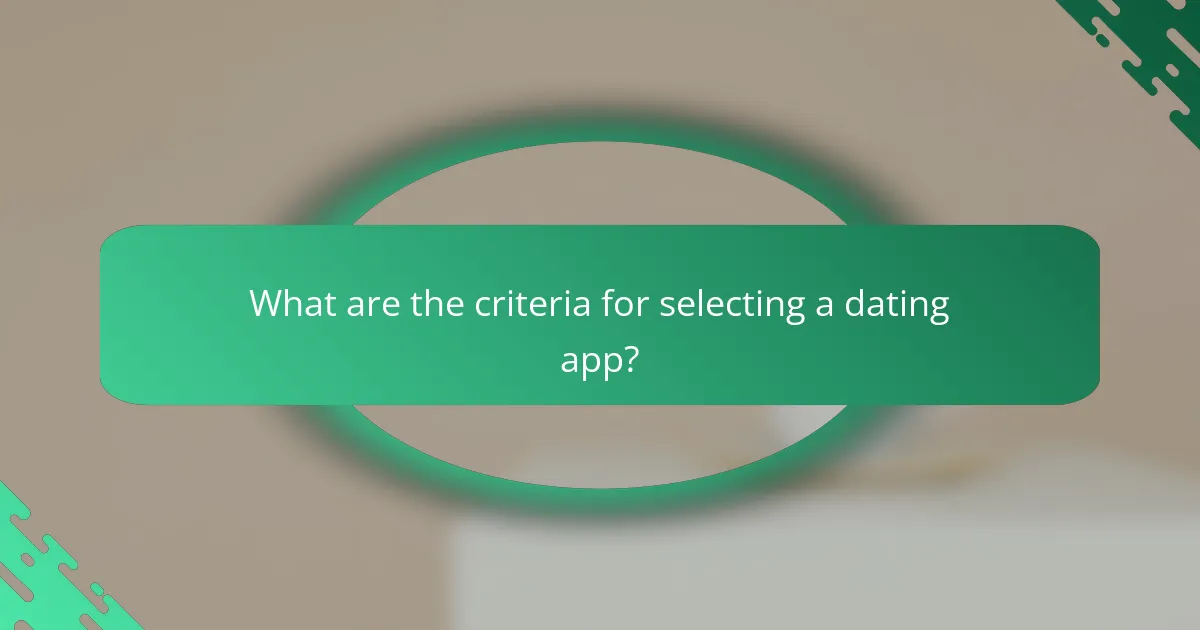
What are the criteria for selecting a dating app?
Selecting a dating app involves evaluating several key criteria that align with your dating goals and preferences. Important factors include the target audience, feature set, user experience, and overall cost-effectiveness.
Target audience alignment
Understanding the target audience of a dating app is crucial for effective matchmaking. Different apps cater to various demographics, such as age groups, interests, or relationship types. For example, some platforms focus on casual dating, while others are designed for serious relationships.
When choosing an app, consider whether its user base matches your preferences. Look for apps that highlight their target audience in marketing materials or user testimonials to ensure compatibility.
Feature set comparison
Evaluating the feature set of dating apps can help you determine which one best meets your needs. Common features include messaging options, profile customization, search filters, and safety tools. Some apps may offer unique features like video calls or compatibility quizzes.
Compare the features of different apps to see which ones provide the tools you need for successful interactions. For instance, if you value privacy, look for apps with robust security measures or options to hide your profile from certain users.
